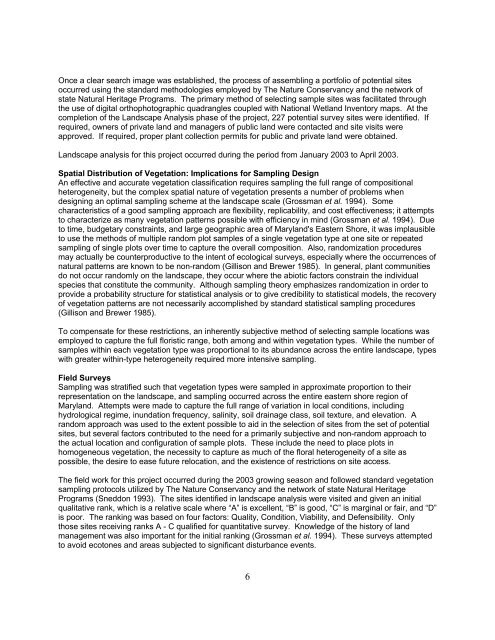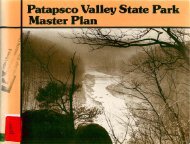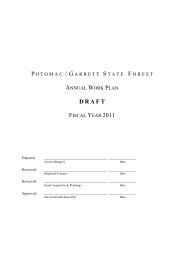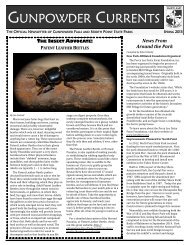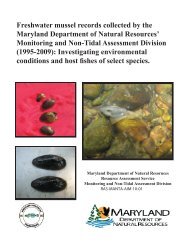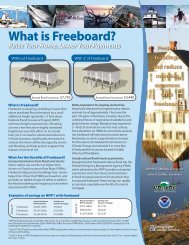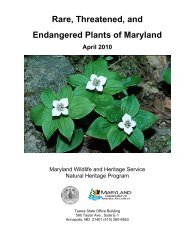tidal hardwood swamps - Maryland Department of Natural Resources
tidal hardwood swamps - Maryland Department of Natural Resources
tidal hardwood swamps - Maryland Department of Natural Resources
You also want an ePaper? Increase the reach of your titles
YUMPU automatically turns print PDFs into web optimized ePapers that Google loves.
Once a clear search image was established, the process <strong>of</strong> assembling a portfolio <strong>of</strong> potential sites<br />
occurred using the standard methodologies employed by The Nature Conservancy and the network <strong>of</strong><br />
state <strong>Natural</strong> Heritage Programs. The primary method <strong>of</strong> selecting sample sites was facilitated through<br />
the use <strong>of</strong> digital orthophotographic quadrangles coupled with National Wetland Inventory maps. At the<br />
completion <strong>of</strong> the Landscape Analysis phase <strong>of</strong> the project, 227 potential survey sites were identified. If<br />
required, owners <strong>of</strong> private land and managers <strong>of</strong> public land were contacted and site visits were<br />
approved. If required, proper plant collection permits for public and private land were obtained.<br />
Landscape analysis for this project occurred during the period from January 2003 to April 2003.<br />
Spatial Distribution <strong>of</strong> Vegetation: Implications for Sampling Design<br />
An effective and accurate vegetation classification requires sampling the full range <strong>of</strong> compositional<br />
heterogeneity, but the complex spatial nature <strong>of</strong> vegetation presents a number <strong>of</strong> problems when<br />
designing an optimal sampling scheme at the landscape scale (Grossman et al. 1994). Some<br />
characteristics <strong>of</strong> a good sampling approach are flexibility, replicability, and cost effectiveness; it attempts<br />
to characterize as many vegetation patterns possible with efficiency in mind (Grossman et al. 1994). Due<br />
to time, budgetary constraints, and large geographic area <strong>of</strong> <strong>Maryland</strong>'s Eastern Shore, it was implausible<br />
to use the methods <strong>of</strong> multiple random plot samples <strong>of</strong> a single vegetation type at one site or repeated<br />
sampling <strong>of</strong> single plots over time to capture the overall composition. Also, randomization procedures<br />
may actually be counterproductive to the intent <strong>of</strong> ecological surveys, especially where the occurrences <strong>of</strong><br />
natural patterns are known to be non-random (Gillison and Brewer 1985). In general, plant communities<br />
do not occur randomly on the landscape, they occur where the abiotic factors constrain the individual<br />
species that constitute the community. Although sampling theory emphasizes randomization in order to<br />
provide a probability structure for statistical analysis or to give credibility to statistical models, the recovery<br />
<strong>of</strong> vegetation patterns are not necessarily accomplished by standard statistical sampling procedures<br />
(Gillison and Brewer 1985).<br />
To compensate for these restrictions, an inherently subjective method <strong>of</strong> selecting sample locations was<br />
employed to capture the full floristic range, both among and within vegetation types. While the number <strong>of</strong><br />
samples within each vegetation type was proportional to its abundance across the entire landscape, types<br />
with greater within-type heterogeneity required more intensive sampling.<br />
Field Surveys<br />
Sampling was stratified such that vegetation types were sampled in approximate proportion to their<br />
representation on the landscape, and sampling occurred across the entire eastern shore region <strong>of</strong><br />
<strong>Maryland</strong>. Attempts were made to capture the full range <strong>of</strong> variation in local conditions, including<br />
hydrological regime, inundation frequency, salinity, soil drainage class, soil texture, and elevation. A<br />
random approach was used to the extent possible to aid in the selection <strong>of</strong> sites from the set <strong>of</strong> potential<br />
sites, but several factors contributed to the need for a primarily subjective and non-random approach to<br />
the actual location and configuration <strong>of</strong> sample plots. These include the need to place plots in<br />
homogeneous vegetation, the necessity to capture as much <strong>of</strong> the floral heterogeneity <strong>of</strong> a site as<br />
possible, the desire to ease future relocation, and the existence <strong>of</strong> restrictions on site access.<br />
The field work for this project occurred during the 2003 growing season and followed standard vegetation<br />
sampling protocols utilized by The Nature Conservancy and the network <strong>of</strong> state <strong>Natural</strong> Heritage<br />
Programs (Sneddon 1993). The sites identified in landscape analysis were visited and given an initial<br />
qualitative rank, which is a relative scale where “A” is excellent, “B” is good, “C” is marginal or fair, and “D”<br />
is poor. The ranking was based on four factors: Quality, Condition, Viability, and Defensibility. Only<br />
those sites receiving ranks A - C qualified for quantitative survey. Knowledge <strong>of</strong> the history <strong>of</strong> land<br />
management was also important for the initial ranking (Grossman et al. 1994). These surveys attempted<br />
to avoid ecotones and areas subjected to significant disturbance events.<br />
6


